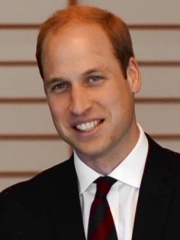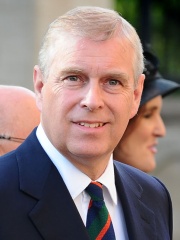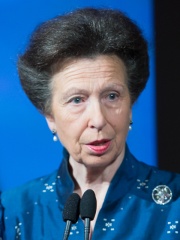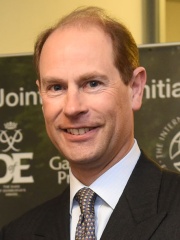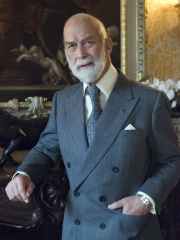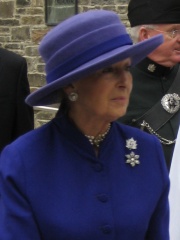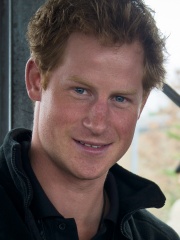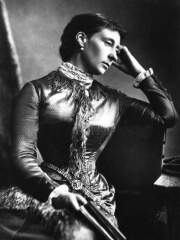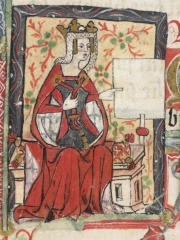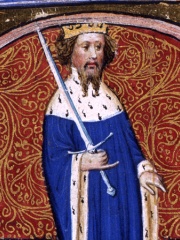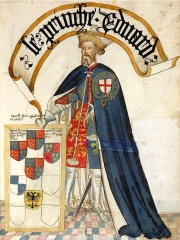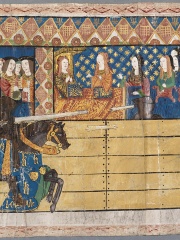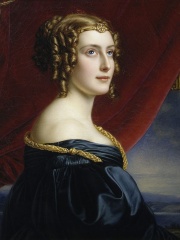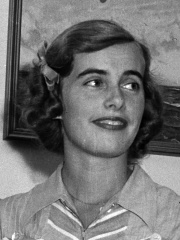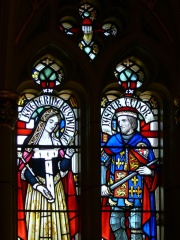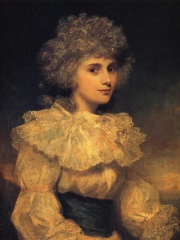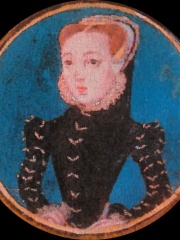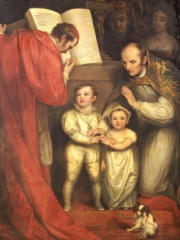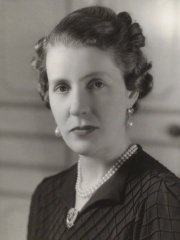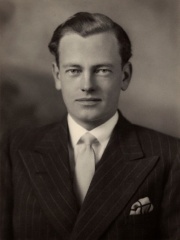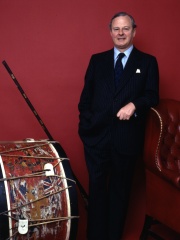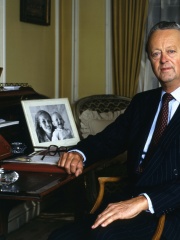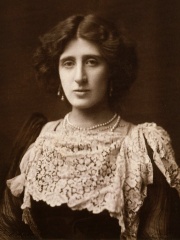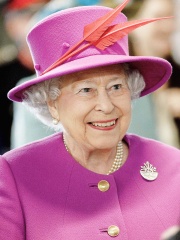
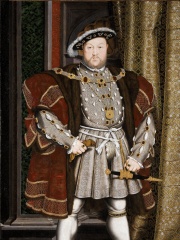
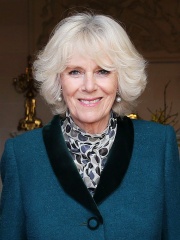
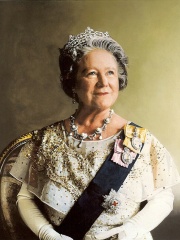
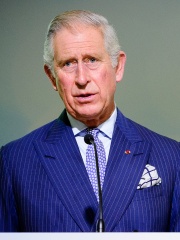


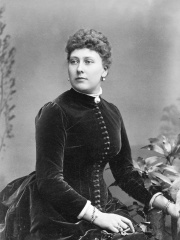
The Most Famous
NOBLEMEN from United Kingdom
This page contains a list of the greatest British Noblemen. The pantheon dataset contains 1,415 Noblemen, 71 of which were born in United Kingdom. This makes United Kingdom the birth place of the 4th most number of Noblemen behind France, and Italy.
Top 10
The following people are considered by Pantheon to be the top 10 most legendary British Noblemen of all time. This list of famous British Noblemen is sorted by HPI (Historical Popularity Index), a metric that aggregates information on a biography’s online popularity. Visit the rankings page to view the entire list of British Noblemen.

1. Elizabeth II (1926 - 2022)
With an HPI of 87.53, Elizabeth II is the most famous British Nobleman. Her biography has been translated into 202 different languages on wikipedia.
Elizabeth II (Elizabeth Alexandra Mary; 21 April 1926 – 8 September 2022) was Queen of the United Kingdom and other Commonwealth realms from 6 February 1952 until her death in 2022. She was queen regnant of 32 sovereign states over the course of her lifetime and remained the monarch of 15 realms by the time of her death. Her reign of over 70 years is the longest of any British monarch, the longest of any female monarch, and the second longest verified reign of any monarch of a sovereign state in history. Elizabeth was born in Mayfair, London, during the reign of her paternal grandfather, King George V. She was the first child of the Duke and Duchess of York (later King George VI and Queen Elizabeth The Queen Mother). Her father acceded to the throne in 1936 upon the abdication of his brother Edward VIII, making the ten-year-old Princess Elizabeth the heir presumptive. She was educated privately at home and began to undertake public duties during the Second World War, serving in the Auxiliary Territorial Service. In November 1947, she married Philip Mountbatten, a former prince of Greece and Denmark, and their marriage lasted 73 years until his death in 2021. They had four children: Charles, Anne, Andrew, and Edward. When her father died in February 1952, Elizabeth—then 25 years old—became queen of seven independent Commonwealth countries: the United Kingdom, Canada, Australia, New Zealand, South Africa, Pakistan, and Ceylon (known today as Sri Lanka), as well as head of the Commonwealth. Elizabeth reigned as a constitutional monarch through major political changes such as the Troubles in Northern Ireland, devolution in the United Kingdom, the decolonisation of Africa, and the United Kingdom's accession to the European Communities, as well as its subsequent withdrawal. The number of her realms varied over time as territories gained independence and some realms became republics. As queen, Elizabeth was served by more than 170 prime ministers across her realms. Her many historic visits and meetings included state visits to China in 1986, to Russia in 1994, and to the Republic of Ireland in 2011, and meetings with five popes and fourteen US presidents. Significant events included Elizabeth's coronation in 1953 and the celebrations of her Silver, Golden, Diamond, and Platinum jubilees in 1977, 2002, 2012, and 2022, respectively. Although she faced occasional republican sentiment and media criticism of her family—particularly after the breakdowns of her children's marriages, her annus horribilis in 1992, and the death in 1997 of her former daughter-in-law Diana—support for the monarchy in the United Kingdom remained consistently high throughout her lifetime, as did her personal popularity. Elizabeth died at the age of 96 at Balmoral Castle, and was succeeded by her eldest son, Charles III.

2. Henry VIII of England (1491 - 1547)
With an HPI of 82.37, Henry VIII of England is the 2nd most famous British Nobleman. His biography has been translated into 104 different languages.
Henry VIII (28 June 1491 – 28 January 1547) was King of England from 22 April 1509 until his death in 1547. Henry is known for his six marriages and his efforts to have his first marriage (to Catherine of Aragon) annulled. His disagreement with Pope Clement VII about such an annulment led Henry to initiate the English Reformation, separating the Church of England from papal authority. He appointed himself Supreme Head of the Church of England and dissolved convents and monasteries, for which he was excommunicated by the pope. Henry brought radical changes to the Constitution of England, expanding royal power and ushering in the theory of the divine right of kings in opposition to papal supremacy. He frequently used charges of treason and heresy to quell dissent, and those accused were often executed without a formal trial using bills of attainder. He achieved many of his political aims through his chief ministers, some of whom were banished or executed when they fell out of his favour. Thomas Wolsey, Thomas More, Thomas Cromwell, and Thomas Cranmer all figured prominently in his administration. Henry was an extravagant spender, using proceeds from the dissolution of the monasteries and acts of the Reformation Parliament. He converted money that was formerly paid to Rome into royal revenue. Despite the money from these sources, he was often on the verge of financial ruin due to personal extravagance and costly and largely unproductive wars, particularly with King Francis I of France, Holy Roman Emperor Charles V, King James V of Scotland, and the Scottish regency under the Earl of Arran and Mary of Guise. He expanded the Royal Navy, oversaw the annexation of Wales to England with the Laws in Wales Acts 1535 and 1542, and was the first English monarch to rule as King of Ireland following the Crown of Ireland Act 1542. Henry's contemporaries considered him an attractive, educated, and accomplished king. He has been described as "one of the most charismatic rulers to sit on the English throne" and his reign described as the "most important" in English history. He was an author and composer. As he aged, he became severely overweight and his health suffered. He is frequently characterised in his later life as a lustful, egotistical, paranoid, and tyrannical monarch. He was succeeded by his son Edward VI.

3. Camilla, Duchess of Cornwall (b. 1947)
With an HPI of 81.09, Camilla, Duchess of Cornwall is the 3rd most famous British Nobleman. Her biography has been translated into 71 different languages.
Camilla (born Camilla Rosemary Shand, later Parker Bowles, 17 July 1947) is Queen of the United Kingdom and the 14 other Commonwealth realms as the wife of King Charles III.Camilla was raised in East Sussex and South Kensington in England and educated in England, Switzerland, and France. In 1973, she married British Army officer Andrew Parker Bowles; they divorced in 1995. Camilla and Charles were romantically involved periodically, both before and during each of their first marriages. Their relationship was highly publicised in the media and attracted worldwide scrutiny. In 2005, Camilla married Charles in the Windsor Guildhall, which was followed by a televised Anglican blessing at St George's Chapel in Windsor Castle. From their marriage until Charles's accession, she was known as the Duchess of Cornwall. On 8 September 2022, Charles became king upon the death of his mother, Queen Elizabeth II, with Camilla as queen consort. Charles and Camilla's coronation took place at Westminster Abbey on 6 May 2023. Camilla carries out public engagements representing the monarch and is the patron of numerous charities and organisations. Since 1994, she has campaigned to raise awareness of osteoporosis, which has earned her several honours and awards. She has also campaigned to raise awareness of issues such as rape, sexual abuse, illiteracy, animal welfare and poverty.

4. Queen Elizabeth The Queen Mother (1900 - 2002)
With an HPI of 77.65, Queen Elizabeth The Queen Mother is the 4th most famous British Nobleman. Her biography has been translated into 71 different languages.
Elizabeth Angela Marguerite Bowes-Lyon (4 August 1900 – 30 March 2002) was Queen of the United Kingdom and the Dominions of the British Commonwealth from 11 December 1936 to 6 February 1952 as the wife of King George VI. She was concurrently the last Empress of India until the British Raj was dissolved in August 1947. After her husband died, she was officially known as Queen Elizabeth The Queen Mother, to avoid confusion with her daughter Queen Elizabeth II. Born into a family of British nobility, Elizabeth came to prominence in 1923 when she married Prince Albert, Duke of York, the second son of King George V and Queen Mary. The couple and their daughters, Elizabeth and Margaret, embodied traditional ideas of family and public service. The Duchess undertook a variety of public engagements and became known for her consistently cheerful countenance.In 1936, Elizabeth's husband unexpectedly became king as George VI when his older brother, Edward VIII, abdicated in order to marry American divorcée Wallis Simpson. Elizabeth then became queen consort. She accompanied her husband on diplomatic tours to France and North America before the start of the Second World War. During the war, her seemingly indomitable spirit provided moral support to the British public. After the war, her husband's health deteriorated, and she was widowed at the age of 51. Her elder daughter, aged 25, became the new queen. After the death of Queen Mary in 1953, Elizabeth was viewed as the matriarch of the British royal family. In her later years, she was a consistently popular member of the family, even at times when other royals were suffering from low levels of public approval. She continued an active public life until just a few months before her death at the age of 101, seven weeks after the death of her younger daughter, Princess Margaret.
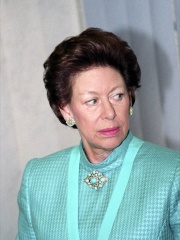
5. Princess Margaret, Countess of Snowdon (1930 - 2002)
With an HPI of 77.24, Princess Margaret, Countess of Snowdon is the 5th most famous British Nobleman. Her biography has been translated into 57 different languages.
Princess Margaret, Countess of Snowdon, (Margaret Rose; 21 August 1930 – 9 February 2002) was the younger daughter of King George VI and Queen Elizabeth The Queen Mother. She was the younger sister and only sibling of Queen Elizabeth II. Margaret was born when her parents were the Duke and Duchess of York, and she spent much of her childhood with them and her elder sister. Her life changed at the age of six, when her father succeeded to the British throne following the abdication of his brother Edward VIII. Margaret's sister became heir presumptive, with Margaret second in line to the throne. Her position in the line of succession diminished over the following decades as Elizabeth's children and grandchildren were born. During the Second World War, the two sisters stayed at Windsor Castle despite suggestions to evacuate them to Canada. During the war years, Margaret was too young to perform official duties and continued her education, being nine years old when the war broke out and turning fifteen just after hostilities ended. From the 1950s onwards, Margaret became one of the world's most celebrated socialites, famed for her glamorous lifestyle and reputed romances. Most famously, she fell in love in the early 1950s with Peter Townsend, a married RAF officer in the royal household. In 1952, her father died, her sister became queen, and Townsend divorced his wife. He proposed to Margaret early in the following year. Many in the government believed that he would be an unsuitable husband for the Queen's 22-year-old sister, and the Archbishop of Canterbury refused to countenance her marriage to a divorced man. Margaret abandoned her plans with Townsend. In 1960, she married Antony Armstrong-Jones, whom Elizabeth created Earl of Snowdon. The couple had two children, David and Sarah. Margaret's marriage to Lord Snowdon became strained, with both of them engaging in extramarital affairs. They separated in 1976 and divorced in 1978. Margaret did not remarry. Margaret was a controversial member of the British royal family. Her divorce received much negative publicity, and her private life was for many years the subject of speculation by media and royal watchers. Her health deteriorated in the last twenty years of her life. She was a heavy smoker for most of her adult life, and had a lung operation in 1985 and a bout of pneumonia in 1993, as well as three strokes between 1998 and 2001. Margaret died in 2002 aged 71, after suffering her fourth stroke.

6. Charles, Prince of Wales (b. 1948)
With an HPI of 76.89, Charles, Prince of Wales is the 6th most famous British Nobleman. His biography has been translated into 138 different languages.
Charles III (Charles Philip Arthur George; born 14 November 1948) is King of the United Kingdom and the 14 other Commonwealth realms.Charles was born in Buckingham Palace during the reign of his maternal grandfather, King George VI, and became heir apparent when his mother, Queen Elizabeth II, acceded to the throne in 1952. He was created Prince of Wales in 1958 and his investiture was held in 1969. He was educated at Cheam School and Gordonstoun, and later spent six months at the Timbertop campus of Geelong Grammar School in Victoria, Australia. After completing a history degree from the University of Cambridge, Charles served in the Royal Air Force and the Royal Navy from 1971 to 1976. In 1981, he married Lady Diana Spencer. They had two sons, William and Harry. Charles and Diana divorced in 1996, after they had each engaged in well-publicised extramarital affairs. Diana died as a result of injuries sustained in a car crash the following year. In 2005, Charles married his long-term partner, Camilla Parker Bowles. As heir apparent, Charles undertook official duties and engagements on behalf of his mother. He founded the Prince's Trust in 1976, sponsored the Prince's Charities, and became patron or president of more than 800 other charities and organisations. He advocated for the conservation of historic buildings and the importance of architecture in society. In that vein, he generated the experimental new town of Poundbury. An environmentalist, Charles supported organic farming and action to prevent climate change during his time as the manager of the Duchy of Cornwall estates, earning him awards and recognition as well as criticism; he is also a prominent critic of the adoption of genetically modified food, while his support for alternative medicine has been criticised. He has authored or co-authored 17 books. Charles became king upon his mother's death in 2022. At the age of 73 he was the oldest person to accede to the British throne, after having been the longest-serving heir apparent and Prince of Wales in British history. Significant events in his reign have included his coronation in 2023 and his cancer diagnosis the following year, the latter of which temporarily suspended planned public engagements.

7. Harold Harefoot (1016 - 1040)
With an HPI of 76.89, Harold Harefoot is the 7th most famous British Nobleman. His biography has been translated into 55 different languages.
Harold I (died 17 March 1040), also known as Harold Harefoot, was regent of England from 1035 to 1037 and King of the English from 1037 to 1040. Harold's nickname "Harefoot" is first recorded as "Harefoh" or "Harefah" in the twelfth century in the history of Ely Abbey, and according to some late medieval chroniclers it meant that he was "fleet of foot".The son of Cnut the Great and Ælfgifu of Northampton, Harold was elected regent of England following the death of his father in 1035. He initially ruled England in place of his brother Harthacnut, who was stuck in Denmark due to a rebellion in Norway which had ousted their brother Svein. Although Harold had wished to be crowned king since 1035, Æthelnoth, Archbishop of Canterbury, refused to do so. It was not until 1037 that Harold, supported by earl Leofric and many others, was officially proclaimed king. The same year, Harold's two step-brothers Edward and Alfred returned to England with a considerable military force. Alfred was captured by Earl Godwin, who had him seized and delivered to an escort of men loyal to Harefoot. While en route to Ely, he was blinded and soon after died of his wounds. Harold died in 1040, having ruled just five years; his half-brother Harthacnut soon returned and took hold of the kingdom peacefully. Harold was originally buried in Westminster, but Harthacnut had his body dragged up and thrown into a fen adjacent to the river Thames, from where it was reportedly recovered by a fisherman and eventually reburied in a Danish cemetery in London.

8. Diana, Princess of Wales (1961 - 1997)
With an HPI of 75.23, Diana, Princess of Wales is the 8th most famous British Nobleman. Her biography has been translated into 118 different languages.
Diana, Princess of Wales (born Diana Frances Spencer; 1 July 1961 – 31 August 1997) was a member of the British royal family and the Spencer family. She was the first wife of Charles III (then Prince of Wales) and mother of Princes William and Harry. Her activism and glamour made her an international icon, and earned her enduring popularity. Diana was born into British nobility, and grew up close to the royal family on their Sandringham estate. In 1981, while working as a nursery teacher's assistant, she became engaged to Charles, the eldest son of Elizabeth II. Their wedding took place at St Paul's Cathedral in July 1981 and made her Princess of Wales, a role in which she was enthusiastically received by the public. The couple had two sons, William and Harry, who were then respectively second and third in the line of succession to the British throne. Diana's marriage to Charles suffered due to their incompatibility and extramarital affairs. They separated in 1992, soon after the breakdown of their relationship became public knowledge. Their marital difficulties were widely publicised, and the couple divorced in 1996. As Princess of Wales, Diana undertook royal duties on behalf of the Queen and represented her at functions across the Commonwealth realms. She was celebrated in the media for her unconventional approach to charity work. Her patronages were initially centred on children and the elderly, but she later became known for her involvement in two particular campaigns: one involved the social attitudes towards and the acceptance of AIDS patients, and the other for the removal of landmines, promoted through the International Red Cross. She also raised awareness and advocated for ways to help people affected by cancer and mental illness. Diana was initially noted for her shyness, but her charisma and friendliness endeared her to the public and helped her reputation survive the public collapse of her marriage. Considered photogenic, she is regarded as a fashion icon of the 1980s and 1990s. In August 1997, Diana died in a car crash in Paris; the incident led to extensive public mourning and global media attention. An inquest returned a verdict of unlawful killing following Operation Paget, an investigation by the Metropolitan Police. Her legacy has had a significant effect on the royal family and British society.

9. Princess Beatrice of the United Kingdom (1857 - 1944)
With an HPI of 74.12, Princess Beatrice of the United Kingdom is the 9th most famous British Nobleman. Her biography has been translated into 39 different languages.
Princess Beatrice (Beatrice Mary Victoria Feodore; 14 April 1857 – 26 October 1944), later Princess Henry of Battenberg, was the fifth daughter and youngest child of Queen Victoria and Prince Albert. Beatrice was also the last of Queen Victoria's children to die, nearly 66 years after the first, her elder sister Alice. Beatrice's childhood coincided with Queen Victoria's grief following the death of her husband on 14 December 1861. As her elder sisters married and left their mother, the Queen came to rely on the company of her youngest daughter, whom she called "Baby" for most of her childhood. Beatrice was brought up to stay with her mother always and she soon resigned herself to her fate. The Queen was so set against her youngest daughter marrying that she refused to discuss the possibility. Nevertheless, many suitors were put forward, including Louis Napoléon, Prince Imperial, the son of the exiled Emperor Napoleon III of France, and Louis IV, Grand Duke of Hesse, the widower of Beatrice's older sister Alice. She was attracted to the Prince Imperial and there was talk of a possible marriage, but he was killed in the Anglo-Zulu War in 1879. Beatrice fell in love with Prince Henry of Battenberg, the son of Prince Alexander of Hesse and by Rhine and Julia von Hauke and brother-in-law of her niece Princess Victoria of Hesse and by Rhine. After a year of persuasion, the Queen, whose consent was required pursuant to the Royal Marriages Act, finally agreed to the marriage, which took place at Whippingham on the Isle of Wight on 23 July 1885. Queen Victoria consented on condition that Beatrice and Henry make their home with her and that Beatrice continue her duties as the Queen's unofficial secretary. The Prince and Princess had four children, but 10 years into their marriage, on 20 January 1896, Prince Henry died of malaria while fighting in the Anglo-Asante War. Beatrice remained at her mother's side until Queen Victoria died on 22 January 1901. Beatrice devoted the next 30 years to editing Queen Victoria's journals as her designated literary executor and continued to make public appearances. She died aged 87 in 1944.
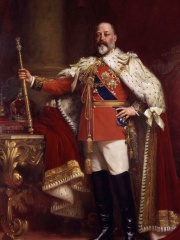
10. Edward VII (1841 - 1910)
With an HPI of 73.01, Edward VII is the 10th most famous British Nobleman. His biography has been translated into 94 different languages.
Edward VII (Albert Edward; 9 November 1841 – 6 May 1910) was King of the United Kingdom and the British Dominions, and Emperor of India, from 22 January 1901 until his death in 1910. The second child and eldest son of Queen Victoria and Prince Albert of Saxe-Coburg and Gotha, Edward, nicknamed "Bertie", was related to royalty throughout Europe. He was Prince of Wales and heir apparent to the British throne for almost 60 years. During his mother's reign, he was largely excluded from political influence and came to personify the fashionable, leisured elite. He married Princess Alexandra of Denmark in 1863, and the couple had six children. As Prince of Wales, Edward travelled throughout Britain performing ceremonial public duties and represented Britain on visits abroad. His tours of North America in 1860 and of the Indian subcontinent in 1875 proved popular successes, but despite public approval, his reputation as a playboy prince soured his relationship with his mother. Edward inherited the throne upon his mother's death in 1901. The King played a role in the modernisation of the British Home Fleet and the reorganisation of the British Army after the Second Boer War of 1899–1902. He re-instituted traditional ceremonies as public displays and broadened the range of people with whom royalty socialised. He fostered good relations between Britain and other European countries, especially France, for which he was popularly called "Peacemaker", but his relationship with his nephew, German Emperor Wilhelm II, was poor. The Edwardian era, which covered Edward's reign and was named after him, coincided with the start of a new century and heralded significant changes in technology and society, including steam turbine propulsion and the rise of socialism. He died in 1910 in the midst of a constitutional crisis that was resolved the following year by the Parliament Act 1911, which restricted the power of the unelected House of Lords. Edward was succeeded by his only surviving son, George V.
People
Pantheon has 85 people classified as British noblemen born between 575 and 2019. Of these 85, 22 (25.88%) of them are still alive today. The most famous living British noblemen include Camilla, Duchess of Cornwall, Charles, Prince of Wales, and Prince William, Duke of Cambridge. The most famous deceased British noblemen include Elizabeth II, Henry VIII of England, and Queen Elizabeth The Queen Mother. As of April 2024, 14 new British noblemen have been added to Pantheon including Henry, Duke of Cornwall, Jane Digby, and Patricia Knatchbull, 2nd Countess Mountbatten of Burma.
Living British Noblemen
Go to all RankingsCamilla, Duchess of Cornwall
1947 - Present
HPI: 81.09
Charles, Prince of Wales
1948 - Present
HPI: 76.89
Prince William, Duke of Cambridge
1982 - Present
HPI: 69.91
Prince Andrew, Duke of York
1960 - Present
HPI: 66.91
Anne, Princess Royal
1950 - Present
HPI: 66.55
Prince Edward, Earl of Wessex
1964 - Present
HPI: 62.36
Prince Michael of Kent
1942 - Present
HPI: 60.24
Lady Sarah Chatto
1964 - Present
HPI: 59.97
Princess Alexandra, The Honourable Lady Ogilvy
1936 - Present
HPI: 59.27
Prince Harry, Duke of Sussex
1984 - Present
HPI: 54.55
Princess Eugenie of York
1990 - Present
HPI: 53.52
Peter Phillips
1977 - Present
HPI: 49.55
Deceased British Noblemen
Go to all RankingsElizabeth II
1926 - 2022
HPI: 87.53
Henry VIII of England
1491 - 1547
HPI: 82.37
Queen Elizabeth The Queen Mother
1900 - 2002
HPI: 77.65
Princess Margaret, Countess of Snowdon
1930 - 2002
HPI: 77.24
Harold Harefoot
1016 - 1040
HPI: 76.89
Diana, Princess of Wales
1961 - 1997
HPI: 75.23
Princess Beatrice of the United Kingdom
1857 - 1944
HPI: 74.12
Edward VII
1841 - 1910
HPI: 73.01
Princess Alice of the United Kingdom
1843 - 1878
HPI: 70.45
Empress Matilda
1102 - 1167
HPI: 70.18
Henry IV of England
1367 - 1413
HPI: 70.17
Edward the Black Prince
1330 - 1376
HPI: 69.53
Newly Added British Noblemen (2024)
Go to all RankingsHenry, Duke of Cornwall
1511 - Present
HPI: 64.28
Jane Digby
1807 - 1881
HPI: 53.37
Patricia Knatchbull, 2nd Countess Mountbatten of Burma
1924 - 2017
HPI: 52.32
Katherine Woodville, Duchess of Buckingham
1458 - 1497
HPI: 52.22
Elizabeth Cavendish, Duchess of Devonshire
1758 - 1824
HPI: 52.02
Amy Robsart
1532 - 1560
HPI: 49.92
Anne de Mowbray, 8th Countess of Norfolk
1472 - 1481
HPI: 49.42
Cynthia Spencer, Countess Spencer
1897 - 1972
HPI: 48.58
David Mountbatten, 3rd Marquess of Milford Haven
1919 - 1970
HPI: 47.59
James Carnegie, 3rd Duke of Fife
1929 - 2015
HPI: 46.65
John Spencer-Churchill, 11th Duke of Marlborough
1926 - 2014
HPI: 45.44
Lady Ottoline Morrell
1873 - 1938
HPI: 41.35
Overlapping Lives
Which Noblemen were alive at the same time? This visualization shows the lifespans of the 25 most globally memorable Noblemen since 1700.

